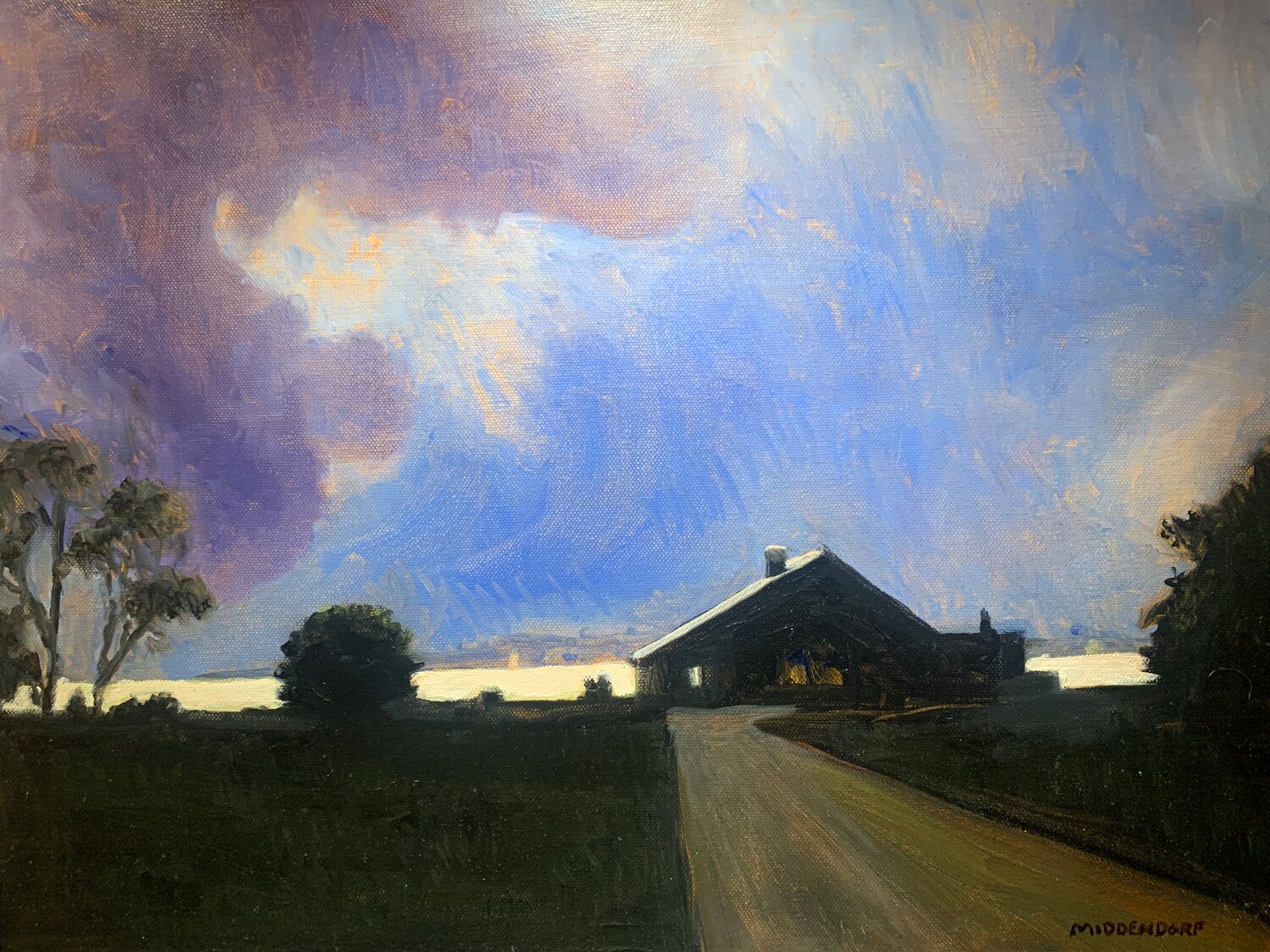An extraordinary life on exhibit in Little Compton
Historical society exhibit hosts paintings by J. William Middendorf — former ambassador, Naval leader and statesman
If you ask J. William Middendorf II, who turns 100 this year, to recount some of the highlights of his remarkable near-century of life — WWII vet, businessman, political mover-and-shaker, …
This item is available in full to subscribers.
Please log in to continue |
Register to post eventsIf you'd like to post an event to our calendar, you can create a free account by clicking here. Note that free accounts do not have access to our subscriber-only content. |
Day pass subscribers
Are you a day pass subscriber who needs to log in? Click here to continue.
An extraordinary life on exhibit in Little Compton
Historical society exhibit hosts paintings by J. William Middendorf — former ambassador, Naval leader and statesman
If you ask J. William Middendorf II, who turns 100 this year, to recount some of the highlights of his remarkable near-century of life — WWII vet, businessman, political mover-and-shaker, presidential advisor, diplomat, artist, poet, composer and author — he will tell you from the get-go that he is, first and foremost, a Navy man to the core.
That’s why Middendorf was so deeply moved when he learned 18 months ago that a U.S. Naval destroyer will be named for him. The ship — the future USS J. William Middendorf (DDG 138), is under construction at the Bath Iron Works in Maine, with an expected completion date some time next year.
During a two-hour interview at his Little Compton home one recent raw and dreary mid-January afternoon, Middendorf displayed a warm, self-effacing manner, a scholarly grasp of history, a cynical view of politicians, and a delightful sense of humor.
Observing his interviewer setting up two recording devices as the conversation got underway, he grumbled with a twinkle in his eye.
“I feel like I’m at the Nuremberg trials.”
Out to sea
Middendorf’s Navy career began when, in the spring of 1944, he transferred from Harvard to Holy Cross in Worcester, where he completed an 18-month officer training program. Upon graduation, armed with a Bachelor of Naval Science degree, he was assigned as an engineering officer and navigator of the LCS(L)53, a floating rocket launcher with 150 rockets mounted on its bow.
In his memoir “Potomac Fever,” Middendorf described the vessel as a “grimy, decrepit hulk,” under the command of a new skipper with a military rank only just slightly higher than his own. Middendorf was just 21 years old, with “no training in the operation of a ship, let alone this one.”
Worse, he was plagued by chronic seasickness his first six months out. His wife, Isabelle, told their children in later years that he was bone thin when he got off the ship.
With the war winding down, his vessel led a squadron of 13 ships ordered to head home across what he described as 7,000 miles of trackless ocean.
“I did, after all, have a degree of sorts in engineering, and was smart enough to be terrified.”
The weather turned sour as the convoy approached Pearl Harbor. He was the officer of the deck on his vessel, meaning he was in charge of driving the ship for his four-hour watch, as conditions deteriorated rapidly.
“As waves hit, the ship would tip over to a frightening angle and shudder for a terrifying moment before slowly coming back, temporarily, to the vertical ... The skipper had literally locked himself in the cabin ... leaving one very seasick, very young, inexperienced officer of the deck to do the best he could,” he wrote.
Middendorf issued orders for empty fuel tanks to be flooded with seawater. When he notified the skipper, who feared the tanks would be contaminated, he was ordered not to proceed.
“I did it anyway, and soon enough, the rolling was not so dramatic and the recovery was more dramatic.”
Commenting on the incident nearly 80 years after the fact, Middendorf compared it to the scene played out in Herman Wouk’s novel, “The Caine Mutiny.” He expressed sympathy for his skipper, however, noting that he had previously endured a couple of months of air raids off of Okinawa, on a vessel credited with shooting down at least nine kamikaze aircraft, and had basically “been through hell.”
A long career
In the decades following his trials at sea, Middendorf worked as an investment banker on Wall Street before deciding to embark on a new career path in Washington, DC. He became a key figure in the Republican party, helping to manage presidential campaigns and ultimately accepting an appointment as treasurer of the Republican National Committee.
The political contacts he made along the way led the late President Richard Nixon to appoint him Ambassador to the Netherlands, a position he held from 1969 to 1973, followed by his appointment as 62nd Secretary of the Navy from 1974 to– 1977.
In that role, he worked to secure Congressional approval of four major new weapons systems that he describes as “so solid, so powerful, they are front and center today, representing the main stage of our national defense 50 years later.” Those efforts, and the impact they made on the nation’s defense system, led Carlos Del Toro, the current Secretary of the Navy, to name the destroyer for him.
The surprise announcement came during graduation ceremonies in 2022 at the Naval War College in Newport.
For Middendorf, the news was completely unexpected. He said later that hardly anyone receives such an honor while still alive. Despite being deeply moved by the announcement, he shed no tears:
“When you get to be 100 years old, you don’t do much crying.”
Artwork
Through the decades, Middendorf’s creative pursuits including his musical compositions, painting, sketching, writing, and poetry, have been an escape and diversion. His art has always been far more than just a hobby, and he has written more than 50 marches for U.S. Navy ships and, while in the Netherlands, composed eight symphonies, including one performed at Queen Juliana’s anniversary celebration of her 25th year reign.
One of his assistants once tallied his work and told him she counted more than 10,000 paintings and sketches. Asked if he would sketch while sitting in presidential cabinet meetings, he said, “of course. I sketched everybody. Everybody.”
To this day, he composes haiku on a daily basis and sometimes posts it on his Facebook page.
He became close to many national and international figures through the years, and he refers to some leaders who have died, such as former President Ronald Reagan and former British Prime Minister Margaret Thatcher, as dear friends. Nonetheless, he is decidedly cynical about some politicians. His haiku verses occasionally reflect that point of view:
Vote for me, says Paul
So I can rob Peter
To pay Paul
Asked if there is a secret formula for achieving so much in one lifetime, Middendorf implied there was nothing extraordinary about his life.
“You put one step in front of the other each day, and eventually you make a few yards.”
See the exhibit
Want to see more?
"To Little Compton With Love, featuring the art and poetry of Ambassador J. William Middendorf II, will run through Friday, February 23, 2024 at the Little Compton Historical Society at 548 West Main Road. The free exhibit runs Tuesday through Friday from 10 a.m. to 5 p.m., with special viewing times also offered for a fee on Saturday and Sunday, Feb. 17 and 18 — call the society at 635-4035 for more information on this.
The exhibit features original paintings, sketches and poetry by Ambassador Middendorf, along with a biographical display highlighting his military and political career.













